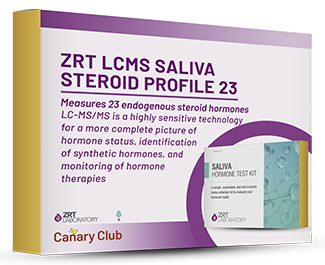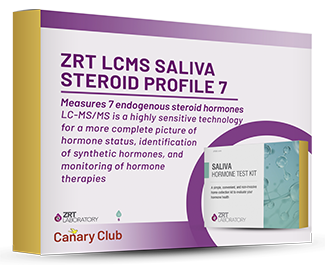How Well is Your Hormone Therapy Doing?
Over the past 25 years, hormone therapies have greatly expanded and diversified. Prescription medicines now target specific hormones to inhibit, excite, or block them.
Today's hormone therapies are used to effectively manage diseases and conditions such as hormone-related breast cancer, prostate enlargement, acne, pattern baldness, thyroid disorders, menopause symptoms, infertility, osteoporosis, endometriosis, polycystic ovary syndrome (PCOS), adrenal insufficiency, growth hormone deficiencies, and new hormone-related contraceptives.
While these treatments offer direct benefits, they also have expected side effects that impact the overall hormonal health of the body, leading to many undesirable consequences.
Fortunately, hormone level testing has evolved alongside these therapies. You can now measure the impact of your hormone therapy on your overall hormone balance. Canary Club offers the LCMS Saliva Steroid Profile newly updated to provide unparalleled sensitivity and specificity, helping you and your healthcare provider monitor and manage your treatment with greater accuracy.
The LCMS method shines a much brighter light on the full steroid hormone cascade and provides more insight into clinical problems that might arise with insufficient or excessive hormone therapies.
This profile tests a broad range of bioidentical hormones, ethinyl estradiol, and several synthetic hormone synthesis inhibitors from one convenient saliva sample collection. An LCMS test is ideal if you or any of your close or extended family are on any form of hormone therapy or taking substances that disrupt your natural hormones.
LCMS Saliva Steroid Profile:
- Ethinyl estradiol is the most common component of oral contraceptives. Testing ethinyl estradiol along with other estrogens in the profile helps providers assess the total body burden of estrogens in people using most oral birth control formulations, thereby understanding symptoms in light of their overall hormone picture.
- Accurately reports on hormones often present and active at low levels, such as estrogens and androgens seen in men, children, postmenopausal women, and people using aromatase and 5a-reductase inhibitors of hormone synthesis.
- Offers a comprehensive range of androgen tests for a full assessment of women with hair loss or acne. Saliva melatonin has been added to this new profile to provide an assessment of real-time waking melatonin production to help identify possible sleep problems.
- To complete the hormone picture, included are the hormone blockers anastrozole, letrozole, and finasteride to evaluate the effects of these drugs on steroid hormone metabolism in terms of buildup or deficiency of key hormones, as well as treatment compliance.
ZRT LCMS Saliva Steroid Profile 7 & 23
Check out our ZRT LCMS Saliva Steroid Profile 23 and ZRT LCMS Saliva Steroid Profile 7 to see how your hormone therapy affects your overall hormone levels. Both profiles use saliva samples.
You can also download the following PDF files that apply to both the 7-hormone and 23-hormone profiles
- LCMS Saliva Reference Ranges
- LCMS Saliva Profile - Sample Report
- LCMS - Saliva Collection Instructions
What is the difference between the LCMS 7-hormone profile and the 23-hormone profile?
The LCMS 7-hormone profile includes the basic hormones typically ordered by people who want to know about the primary hormones associated with most endocrine problems. This profile focuses on essential hormones that provide critical information for helping your practitioner to manage common hormone-related issues.
In contrast, the 23-hormone profile offers a much broader panel of hormones that are particularly useful for understanding complex steroid hormone problems of the endocrine system. This comprehensive profile is valuable for monitoring conditions such as polycystic ovary syndrome (PCOS), various forms of congenital adrenal hyperplasia (CAH), premenstrual syndrome (PMS), and premenstrual dysphoric disorder (PMDD). It provides a more detailed view of hormone interactions and imbalances that contribute to these complex conditions.
Enhanced Understanding with LCMS Testing
The LCMS test is also an excellent tool for understanding the pathways that precursor hormone therapies (e.g., pregnenolone, DHEA, progesterone, testosterone) take to become active estrogens, progestogens, androgens, glucocorticoids, and mineralocorticoids. It can determine how different types of hormones and their administration routes (e.g., oral, topical, transdermal patch, IM/SC injections, pellet, vaginal) affect their bioavailable (saliva) and total blood (DBS) levels.
Comprehensive Insights into Hormone Therapy
The LCMS method provides a detailed and comprehensive view of the full steroid hormone cascade, offering insight into clinical problems that might arise from insufficient or excessive hormone therapies. It enhances the ability to monitor and adjust hormone therapies effectively, ensuring that hormone levels are optimized for specific needs.
Collecting Samples for the LCMS Saliva Steroid Profiles
One large saliva collection tube is provided to be used upon waking. Start saliva collection within five minutes of waking for the day. (See: LCMS - Saliva Collection Instructions)
Looking for a Health Coach?
Have questions on interpreting the results of this test? If you aren’t already working with a practitioner, have a look at our Health Care Coaches page for additional information and resources.
Your Hormone Management Testing Plan
- Step 1: Start by selecting and ordering your desired test(s). You will receive an at-home testing kit that fits your unique concerns and needs. No prescription or visit to the doctor’s office is required. Your test kit is delivered directly to your front door.
- Step 2: Take the test to establish the starting hormone baseline at the beginning of your plan. Consider developing your plan alongside:
- a licensed health care provider for medical conditions, especially for severe "out of normal range" results
- or a Health Care Coach for nutrition and supplements that will support your desired results
- Step 3: Develop a plan based on your hormone test results, establishing a one-year or more outlook.
- Keep logs of your intakes, and daily routines related to your hormone test results.
- Keep logs of your intakes, and daily routines related to your hormone test results.
- Step 4: After 6-12 months of actively working on your plan, take the same test again to determine your progress.
From all of us at the Canary Club,
Here’s to knowing ourselves and taking positive action!




